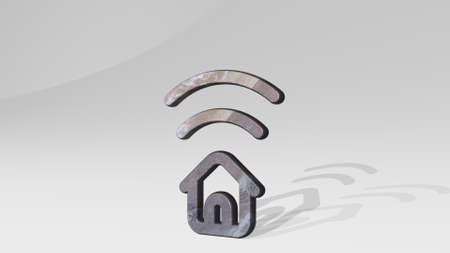1. The Evolution of Smart Home Connectivity
Smart home technology has come a long way over the past few decades. What started with simple remote-controlled garage doors and programmable thermostats has evolved into fully connected homes with voice assistants, intelligent lighting, smart locks, and appliances that can be monitored and controlled from anywhere. As these devices have become more advanced, the demand for faster, more reliable connectivity has also increased.
The Early Days of Smart Homes
In the early 2000s, smart home systems were primarily wired and expensive, typically limited to luxury homes or tech enthusiasts. These systems relied heavily on local networks and required professional installation. Wireless technology was not yet stable enough to support a wide range of connected devices reliably.
The Rise of Wi-Fi and Mobile Networks
With the rise of Wi-Fi in the late 2000s and early 2010s, smart home devices became more accessible to everyday consumers. Wi-Fi allowed homeowners to connect devices like smart TVs, security cameras, and thermostats without extensive wiring. At the same time, improvements in mobile networks—from 3G to 4G LTE—enabled remote control through smartphones and cloud-based services.
Connectivity Evolution Table
| Time Period | Technology | Main Features | Limitations |
|---|---|---|---|
| Early 2000s | Wired Systems | Reliable but limited to local control | Expensive; complex installation |
| Late 2000s–2010s | Wi-Fi & 4G LTE | Wireless access; mobile app control | Limited bandwidth; latency issues with many devices |
| 2020s and Beyond | Wi-Fi 6 & 5G | High speed; low latency; supports many devices at once | Still expanding infrastructure in some areas |
Meeting Growing Consumer Demands
As smart homes became mainstream, consumers began expecting seamless performance from their connected devices. Whether its streaming high-definition video from a doorbell camera or managing multiple smart lights simultaneously, the need for robust connectivity grew. This demand paved the way for next-gen solutions like Wi-Fi 6 and 5G—both designed to handle the increasing number of IoT (Internet of Things) devices in modern homes.
2. What 5G Means for Smart Homes
5G is not just the next step in mobile connectivity—its a game-changer for smart homes. With ultra-fast speeds and significantly lower latency compared to 4G, 5G unlocks new possibilities for home automation, real-time control, and seamless device integration. Heres how this next-generation technology is shaping the future of connected living spaces.
Faster Speeds, Smarter Devices
One of the biggest advantages of 5G is its speed. With data transfer rates up to 100 times faster than 4G, smart home devices can communicate more efficiently. This means quicker response times when you control lights, locks, thermostats, or cameras from your smartphone or voice assistant.
Low Latency Enables Real-Time Control
Latency refers to the delay between sending a command and getting a response. With 5G’s latency as low as 1 millisecond, smart home devices can react almost instantly. This is especially important for security systems, video doorbells, and remote-controlled appliances where timing is critical.
More Devices, Less Interference
As homes become packed with connected gadgets—from smart TVs to kitchen appliances—network congestion becomes a problem. 5G’s ability to handle more devices simultaneously without slowing down makes it ideal for busy households relying on multiple smart technologies at once.
Comparison: 4G vs. 5G in Smart Homes
| Feature | 4G | 5G |
|---|---|---|
| Download Speed | Up to 100 Mbps | Up to 10 Gbps |
| Latency | 30–50 ms | <1 ms |
| Device Capacity | Limited (can cause lag) | Massive (supports IoT expansion) |
| Stability Under Load | May slow down with many devices | Smooth performance even with many devices |
The Impact on Daily Life
Imagine your morning routine: Your alarm goes off, and instantly your coffee maker starts brewing, your blinds open, and the thermostat adjusts—all without any noticeable delay. That level of automation and responsiveness becomes possible with 5G powering your smart home network.
The Road Ahead with 5G-Enabled Homes
As telecom providers expand their 5G coverage across the U.S., homeowners will begin to experience smoother smart home interactions. From enhanced streaming quality to faster updates for connected appliances, the benefits of adopting 5G are becoming more tangible every day.
Real-Life Examples of 5G Use in Smart Homes:
- Smart Security: Real-time HD video streaming from doorbell cameras without lag.
- Elderly Care: Remote monitoring systems that respond instantly in case of emergencies.
- Energy Efficiency: Dynamic control of HVAC systems based on real-time occupancy data.
- Entertainment: Buffer-free streaming on multiple devices simultaneously.
The move toward fully connected homes relies heavily on dependable networks. With its speed and reliability, 5G is set to become the backbone of smarter living environments across America.
![]()
3. The Role of Wi-Fi 6 in Enhancing In-Home Networks
Wi-Fi 6, also known as 802.11ax, is the latest generation of wireless networking technology. It’s designed to handle the growing number of connected devices in today’s smart homes—everything from smart TVs and thermostats to security cameras and voice assistants. With more people working from home and streaming content across multiple devices, traditional Wi-Fi networks can quickly become overloaded. That’s where Wi-Fi 6 steps in.
Why Wi-Fi 6 Matters for Smart Homes
Unlike previous generations, Wi-Fi 6 is built to support high-density environments with multiple users and connected gadgets. It improves overall network performance by offering faster speeds, better efficiency, and lower latency—even when many devices are online at once.
Key Benefits of Wi-Fi 6
| Feature | Benefit for Smart Homes |
|---|---|
| OFDMA (Orthogonal Frequency Division Multiple Access) | Allows your router to communicate with multiple devices at the same time, reducing lag and improving efficiency. |
| TWT (Target Wake Time) | Helps smart home devices save battery life by scheduling check-in times with the router. |
| Increased Bandwidth | Delivers faster internet speeds, especially useful for 4K/8K streaming and video conferencing. |
| Improved Security (WPA3) | Adds a stronger layer of protection for your personal data and devices. |
| MU-MIMO Enhancements | Supports more simultaneous device connections without slowing down performance. |
Real-Life Impact Inside the Home
If you’ve ever experienced buffering during a movie night or lag during a Zoom call, upgrading to a Wi-Fi 6 router could make a noticeable difference. Imagine every family member streaming videos, playing games, or attending virtual meetings at the same time—Wi-Fi 6 handles it all much more smoothly than older standards.
A Strong Foundation for Future Tech
As smart homes continue to evolve with more IoT devices entering the market, having a reliable and efficient local network becomes even more important. Wi-Fi 6 not only meets today’s connectivity demands but also prepares your home for future innovations like AI-powered automation and ultra-HD media streaming.
The integration of Wi-Fi 6 into modern homes creates a stronger backbone for smart living, ensuring that all your connected devices perform at their best—day in and day out.
4. Real-Life Applications and Benefits for Homeowners
With the rise of 5G and Wi-Fi 6, smart homes are becoming more efficient, secure, and enjoyable to live in. These technologies are not just buzzwords—they’re transforming everyday life for homeowners across the U.S. Let’s look at some practical examples of how they’re making a real difference.
Enhanced Home Security
5G and Wi-Fi 6 provide faster, more reliable connections that keep your home security systems running smoothly. Whether it’s high-definition video surveillance or real-time alerts from smart doorbells, these technologies ensure you’re always connected to what matters most.
Key Benefits:
- Faster Video Streaming: View live feeds from your security cameras without lag or buffering.
- More Device Support: Connect multiple cameras, sensors, and smart locks without slowing down your network.
- Instant Notifications: Get real-time alerts on your smartphone when unusual activity is detected.
Smarter Energy Management
A connected home is an energy-efficient home. With 5G and Wi-Fi 6, smart thermostats, lighting systems, and appliances can communicate seamlessly to help you save on utility bills while reducing your carbon footprint.
Example Use Cases:
| Smart Feature | How It Works | User Benefit |
|---|---|---|
| Smart Thermostat | Learns your schedule and adjusts temperature automatically | Saves energy and improves comfort |
| Connected Lighting | Dims or turns off lights based on occupancy and time of day | Lowers electricity usage |
| Energy Monitoring Plugs | Tracks energy use by device in real time | Makes it easier to spot energy hogs |
Immersive Entertainment Experiences
If you love streaming shows, gaming online, or using AR/VR devices, then you’ll appreciate what 5G and Wi-Fi 6 bring to the table. These technologies reduce latency and increase bandwidth, which means smoother experiences for everyone in your household.
User Benefits Include:
- No More Buffering: Stream 4K or even 8K content without interruptions.
- Smoother Gaming: Enjoy lag-free multiplayer games—even with several users online.
- Bigger Bandwidth: Support multiple users streaming or gaming at the same time with no slowdowns.
The Bottom Line for Everyday Living
The shift to 5G and Wi-Fi 6 is more than just a tech upgrade—it’s about creating a smarter, more responsive living environment. From safety and savings to entertainment and convenience, these innovations are helping homeowners take full control of their connected lifestyles like never before.
5. Preparing for a Connected Future
As 5G and Wi-Fi 6 continue to roll out across the U.S., homeowners looking to upgrade or build a smart home need to plan ahead. These advanced technologies offer faster speeds, lower latency, and better support for multiple connected devices—but getting the most out of them requires a solid infrastructure. Here’s what you should consider when preparing your home for this next generation of connectivity.
Upgrade Your Network Hardware
Not all routers and modems support 5G or Wi-Fi 6, so the first step is upgrading your network equipment. Look for a Wi-Fi 6 (802.11ax) router and ensure it has features like MU-MIMO and OFDMA to handle multiple devices efficiently. If youre considering adding 5G as a backup or primary internet source, you may also need a 5G-compatible modem or gateway.
Recommended Hardware Features
| Feature | Description |
|---|---|
| Wi-Fi 6 Support | Faster speeds and better device handling than Wi-Fi 5 |
| MU-MIMO | Allows simultaneous data streaming to multiple devices |
| OFDMA | Improves efficiency and reduces latency in dense networks |
| Mesh Capability | Covers larger homes with consistent signal strength |
Create a Solid Wiring Plan
If youre building or remodeling, now is the time to think about structured wiring. While wireless tech is convenient, having Ethernet cables (Cat6 or higher) run through key areas of the home provides more stable connections—especially for bandwidth-heavy devices like gaming consoles, smart TVs, or security cameras.
Select Compatible Smart Devices
Many new smart home devices are designed to work best with Wi-Fi 6. When shopping for smart thermostats, doorbells, lighting systems, or appliances, check that they support the latest standards for optimal performance.
Plan for Scalability
Your smart home needs will likely grow over time. Choose systems that are modular and easy to expand. A scalable setup ensures you won’t need a complete overhaul when adding new gadgets later on.
Scalability Tips
- Select hubs and controllers that can manage multiple device brands.
- Avoid locking into closed ecosystems unless youre sure of long-term compatibility.
- Keeps firmware updated to maintain security and compatibility with newer devices.
Simplify with Automation Platforms
If you’re juggling several smart devices, consider using platforms like Apple HomeKit, Google Home, or Amazon Alexa to streamline control. These platforms are becoming more compatible with emerging standards like Matter—which makes integration easier across brands.
The Power of Professional Guidance
If this feels overwhelming, don’t hesitate to consult with a smart home integrator or network specialist. They can help design a system tailored to your lifestyle and ensure everything is future-proofed for evolving technologies like 5G and Wi-Fi 6.


